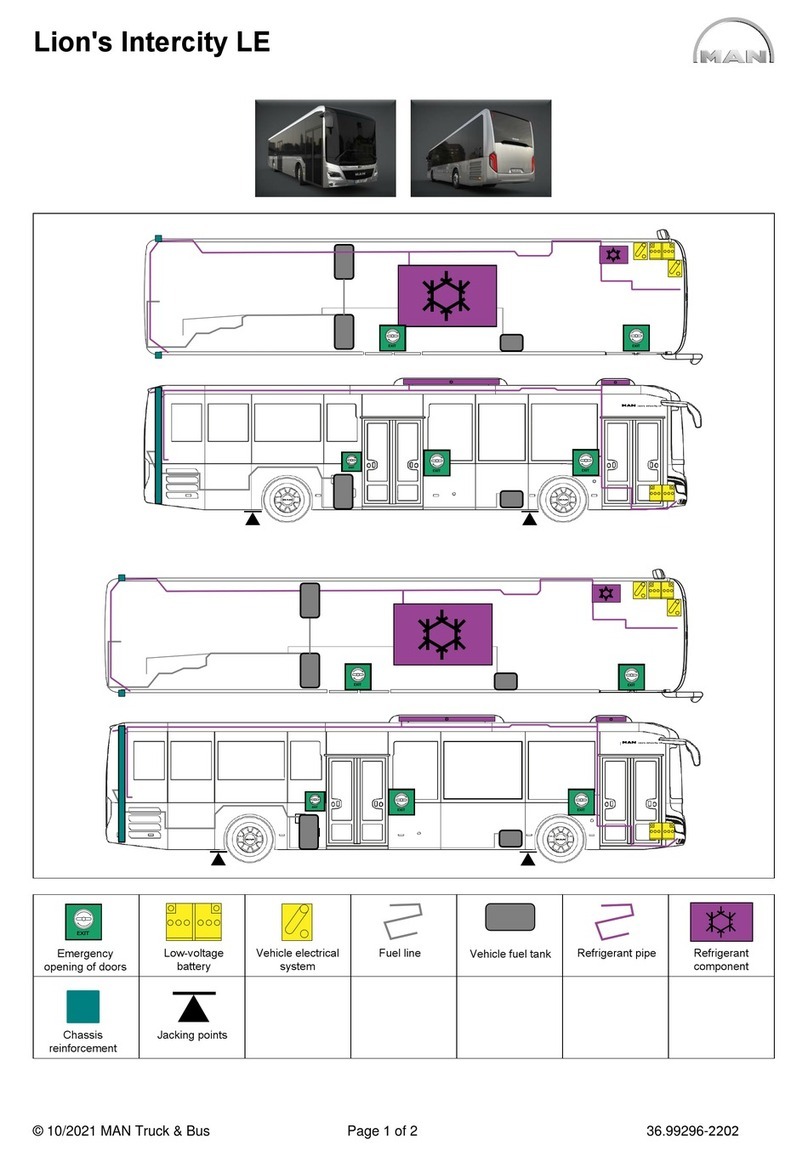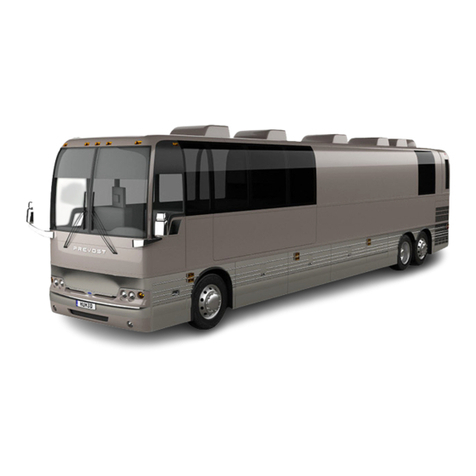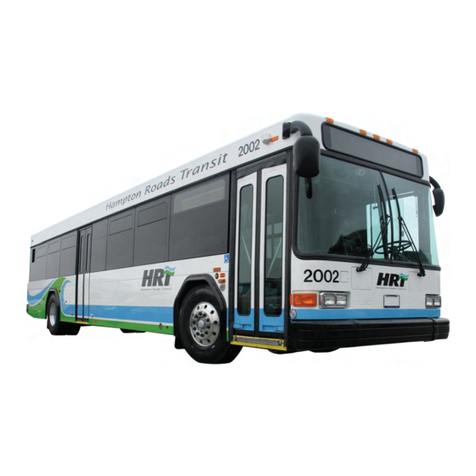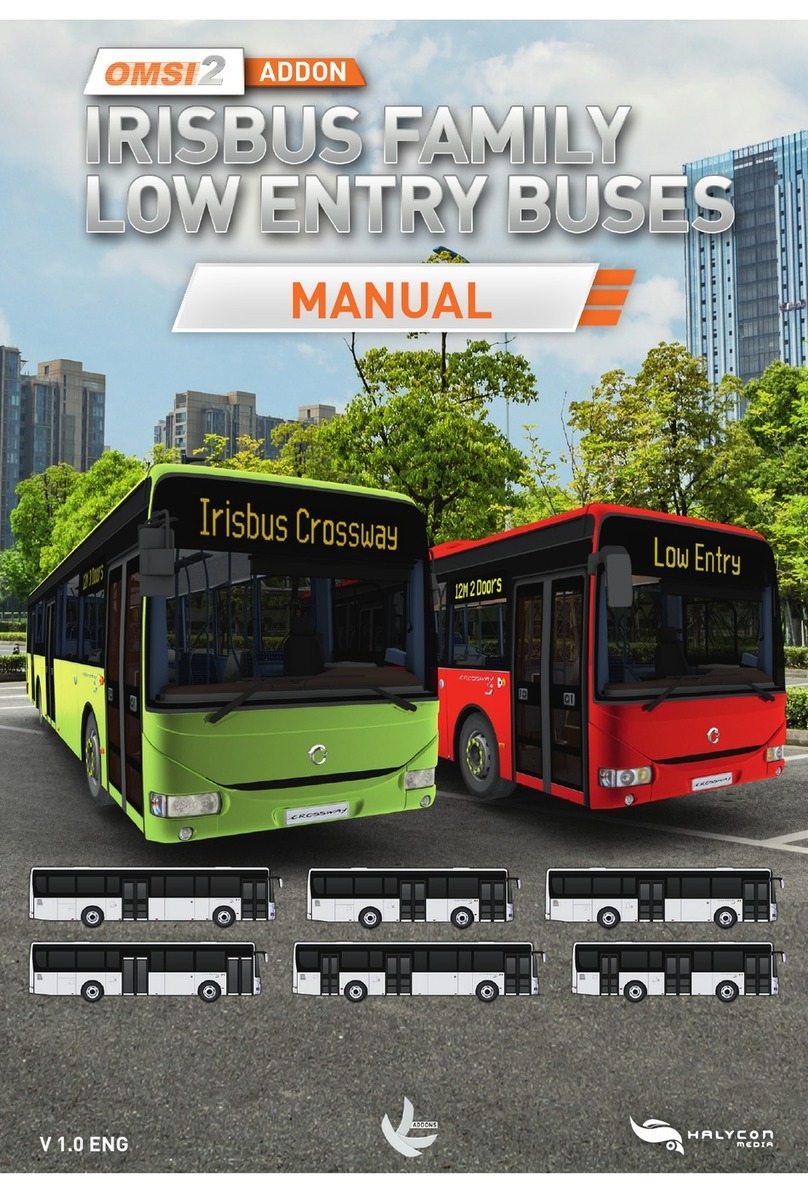Girardin Blue Bird Micro Bird 2014 Instruction Manual

OPERATION AND
MAINTENANCE GUIDE
First edition
2014

First edition released on February 3rd 2014.
Prepared by: Chantal Blanchette, After-Sales Service and Warranty Coordinator
Reproduction of entire or partial content of this manual is not permitted without written
authorization from Corporation Micro Bird Inc.
If you should find a discrepancy between the manual and supplier information, the
supplier information will prevail.
Text, specifications and pictures are those available at time of printing. Manual may be
revised at a later date. If you should require more information, please contact your Blue
Bird Micro Bird dealer.
CORPORATION MICRO BIRD INC. will be defined as Micro Bird throughout this
document.

Congratulations on your recent purchase of a
Blue Bird Micro Bird by Girardin.
We are confident this new acquisition will be a
pleasurable and long lasting experience.

TABLE OF CONTENTS
INTRODUCTION 1
REPORTING SAFETY DEFECTS 2
VEHICLE INFORMATION
Certification plate (details) 3
Tire inflation pressure information 3
Particularities of propane powered vehicles 4
FEATURES AND OPTIONS
Driver control switch panel 5-7
Lights (interior and exterior) 8
Mirrors (interior and exterior) 9
Stop arm and crossing arm 10
Emergency exits 11
Passenger entrance door 12
Rear emergency door 13
Windows 14
CLIMATE SYSTEMS
A/C systems 15
Heaters 16
SEATING
Barrier and kick panel 17
Seats and seatbelts for ambulatory passengers 17-18
Seat anchorages and tether hooks 18
WHEELCHAIR EQUIPMENT
Wheelchair lift 19
Wheelchair passenger seat belts 20
Tie-downs 20
SAFETY EQUIPMENT
Fire Blanket 21
Fire Extinguisher 21
Fire suppression system 21
First aid kit and body fluid kit 21
Seat belt cutter 21
Triangular warning device 21

MISCELLANEOUS ACCESSORIES
Back up alarm 22
Back up camera 22
Battery box 22
Child detection system 23
Fan (Two-speed) 23
Light Hoods 23
Light Monitor 23
Luggage Net 23
Parcel racks 24
Radio 24
Roof vent with electric fan 24
Solar panel 24
Roof deflector 24
Tire chains 24-25
Tv-dvd systems 25
CHECK UP AND MAINTENANCE
Daily pre-trip inspection 26-27
Outside and inside cleaning 27
Periodic check-up and maintenance on body 28-29
A/C system preventive maintenance schedule 30-31
Wheelchair lifts preventive maintenance schedule 32
USEFUL INFORMATION FOR REPAIRS
Electrical panel 33
Wiring schematics 34
TROUBLESHOOTING GUIDE
Index 35
WARRANTY
School bus standard limited warranty 45-46
How to make sure you will be reimbursed for warranty work 47-48
IMPORTANT CONTACT INFORMATION 49
NOTES 50-51

1
INTRODUCTION
This manual is intended to help you to become familiar with your new Blue Bird Micro
Bird by Girardin bus and to act as a reference document for its operation and
maintenance throughout the life of the vehicle. It is designed for use in conjunction with
the original chassis manufacturer’s owner literature and wiring diagrams that were or will
be handed to you. These manuals will help you in case of malfunction of components,
and give information to easily get service covered by warranty.
It is very important that you get familiar with bus operation and all emergency items
present in the vehicle before your first trip. Proper operation, maintenance and service
will ensure safety and reliability of your new Micro Bird.
Your Micro Bird may not have all the equipment mentioned in this manual. All
information is accurate on the date this manual was published. It is possible you may
have an option which is not listed in this manual. For any question on equipment or
maintenance, please contact your Blue Bird Micro Bird dealer.
Should you have any questions regarding the operation of the engine controls, dashboard
controls, seat controls and other original equipment please refer to your Ford or GM
owner’s literature.
To ensure quick reference when you need help, please fill in the contact information
page at the end of this manual.

2
REPORTING SAFETY DEFECTS
UNITED STATES ONLY
If you believe that your vehicle has a defect which could cause a crash or could cause
injury or death, you should immediately inform the National Highway Traffic Safety
Administration (NHTSA) in addition to notifying Micro Bird.
If NHTSA receives similar complaints, it may open an investigation and, if it finds that a
safety defect exists in a group of vehicles, it may order a recall and remedy campaign.
However, NHTSA cannot become involved in individual problems between you, your
dealer, or Micro Bird.
To contact NHTSA, you may call the Vehicle Safety Hotline toll-free at:
1-888-327-4236 (TTY: 1-800-424-9153)
Or go to:
http://www.safercar.gov
Or write to:
Administrator, NHTSA,
400 Seventh Street SW.
Washington, DC 20590
You can also obtain other information about motor vehicle safety from:
http://safercar.gov
CANADA ONLY
If you believe that your vehicle has a defect which could cause a crash or could cause
injury or death, you should immediately inform Transport Canada, using their toll-free
number: 1-800-333-0510 or online at: http://www.tc.gc.ca/eng/roadsafety/menu.htm

3
VEHICLE INFORMATION
CERTIFICATION PLATE
The certification plate is fixed above the driver in front of the bus. This plate certifies the
vehicle conforms to all applicable Federal Motor Vehicle Safety Standards in effect at
date of manufacture.
This is where you will find the VIN and the body number of the bus needed to order parts
or receive guidance on repairs.
This sticker also provides tire pressures and seating capacity details.
** Do not remove this plate under any circumstance.
TIRE INFLATION PRESSURE INFORMATION
The tire pressures can always be found on our certification plate located above the driver
(refer to certification plate mentioned above). These pressures can also be available on
the Tire and Load sticker located on the driver door post for vehicles of less than 10,500
lbs (MBII).

4
PARTICULARITIES OF PROPANE POWERED VEHICLES
How to start the engine:
A propane vehicle engine cannot be started the same way as a vehicle with gas or diesel
fuel. This process is clearly identified on a green card fixed to the key ring when the bus
is delivered to you. One side indicates the customer service phone number at Roush if
you have issues, and the instructions to start the bus are written on the back of the card.
If you do not have this card handy or if it has been lost, follow these simple instructions.
Put key in ignition, turn completely to the end and then slightly back to the ON position.
Your propane vehicle will start after a short delay (approximately 10 seconds).
Emergency shut off valve:
In case of emergency, there is a shut off valve underneath the bus. It is on the left side of
the vehicle, behind the rear wheels. A decal is also installed to quickly find its location.
Use the thumb screw to the left of the box to remove cover.

5
FEATURES AND OPTIONS
DRIVER CONTROL SWITCH PANEL
The quantity of switches in the console will vary with the options ordered for your bus.
Their position can also be different from one bus to the other depending on the switches
installed.
The standard switches which will most always be found in a school bus are:
OPEN / CLOSE : Used to open or close the electric passenger entrance doors.
Make sure to hold the switch until the door is completely opened or closed.
/ MASTER: Used to activate school package. Pressing on the master switch will
arm the system.
/ START: Pressing the start switch will activate the amber lights. When the
passenger entrance door is opened, the red lights will flash, the stop arm and the
crossing arm will deploy. When the entrance door is closed, the lights will turn off
and the stop arm and crossing arm will retract.
** Note that in some states, the wiring will be non-sequencial. This means that
you do not need to depress the start switch to get the red lights to flash. Simply open
the passenger door to activate the red flashers.
FLASHER INDICATOR: These two lights indicate if the amber or red lights are
working.
/ DOME LIGHTS: Turns the dome lights ON or OFF.
HIGH / LOW : This is a three way switch that controls the REAR HEATER
and can be set on low, high or turned off.
/ MIRRORS DEFROST: Turns the heated mirrors ON or OFF.

6
Depending on the customer needs and states requirements, some school busses will be
equipped with more switches. Here are other switches that can be found on the console.
/ STROBE LAMP: Activation of the strobe light located on the roof.
STROBE ON: Indicator showing strobe lamp is flashing.
X-ARM: This switch is used to cancel the crossing arm while school lights are
activated and this option is not needed.
STEP DE-ICER: Activates an electric de-icer system located on the lower step of
the entrance door.
ROOF FAN: Activates the electric fan of the roof hatch or the electric static vent to
control the moisture and help air circulation in the vehicle.
HIGH / LOW : Activates the two speed windshield electric fan located in
the driver’s area.
/ FAST IDLE: Motor’s revolution control system to increase the slow idle time
and helps maintain the battery charge. Available on Ford chassis only.
HEATER VALVE: This switch controls the electric heater valve installed
underneath the bus.
EMER. EXIT: Pilot light indicates if the rear emergency door or any push out
windows are not securely latched.
DOOR LOCKED: The pilot light will warn the driver that the rear emergency door
is locked thus preventing the engine from starting.
NOISE SUPP: This switch will turn off the accessories that could make noise
while approaching a railroad track. (Example: Heater, A/C, Fan, and Radio)
LIFT DOOR: The pilot light will be activated if the lift door is not securely closed
thus preventing the transmission to be changed from park to drive. Depending on the
option chosen, a red light or a pilot light will be installed.

7
CANCEL: This switch stops the cycle of the 8 way flashing lights which was
activated by pressing the START switch.
OVERRIDE: Emergency override switch used to activate red warning lights without
going through the complete sequence usually necessary.
2 INCH RED LIGHT: This light will be activated if the lift door is not closed
securely thus preventing the transmission to be changed from park to drive.
Depending on the option chosen, this red light or the pilot light will be installed.
EXT. SPEAKER: Used with PA system integrated to the CD player. The switch
allows you to choose between interior and exterior speaker.
Control switch buttons may also be present on the bus for additional options.
INDEPENDANT LIGHTING CONTROL: Used to set desired lighting of the
switches located on the console.
A/C CONTROLS: A/C button controls are located on the console to the right of the
driver. With MCC systems, the left button controls the fan setting and the right one is for
temperature control. On vehicles equipped with an ACC system there is be only one
button for fan/heat control.
HEATER VALVE: Located under the dash next to the engine cover, it is used to control
the liquid flow for the rear heater from inside the vehicle.

8
LIGHTS (INTERIOR AND EXTERIOR)
Interior lights: The interior lights can be activated differently as per the options chosen
by the customer. The most common operation is as follows: vehicles rear dome lights
will be activated by a switch in the console. If present, the driver dome light will come
on when the driver door is opened. The dome light above the entrance door as well as the
stepwell light will activate when the entrance door is opened. In some cases, the dome
lights will also come on when the rear door is opened or when the child detection system
is disarmed.
Exterior lights: On GM vehicles, the front and rear clearance lights as well as the
parking lights are activated by the ignition. Note that on Ford vehicles, these lights will
come on as soon as you open the driver’s door. All these lights will stay for a short
period of time after the ignition has been turned off.
The 8 way lights of the vehicle will be controlled by the switches in the console. To
activate, press the start switch. If the vehicle is equipped with a master switch, it will
need to be depressed before activating the start switch. To deactivate the warning lights,
simply close the passenger entrance door.
8 WAY flashers (can be
incandescent or led).
Standard is 4 ambers and
4 reds. In some states
they may all be red.
Stop and tail red led lights
Directional led light
Yellow
Back up white led light
Exterior light side lift door
Side
directional led
light armored
Exterior light entrance door
Strobe light
Step well light
Clearance and
identification lights

9
MIRRORS (INTERIOR AND EXTERIOR)
Interior mirrors:
Located above the driver, a rearview mirror will allow a quick look at the passengers
without turning around.
Some vehicles do not have the original OEM rearview mirror which is replaced by a
special rearview mirror with an integrated back up camera.
Exterior mirrors:
The outside rearview mirrors are designed to provide the seated driver a view of the
roadway to the rear and to the sides of the bus.
The elliptical crossview mirrors are designed to allow a seated driver to view all areas
around the front of the bus not otherwise visible. The crossview mirrors are designed to
be used to view pedestrian while the bus is stopped. They must not be used to view
traffic while the bus is moving. Image, road vibrations and shape of mirror will give
a distorted image and would not accurately show another vehicle location.
As the busses can be used by different drivers, these mirrors should be verified and
adjusted each morning if needed, to make sure the driver has a clear view of these areas.
The heated mirrors are controlled by a switch in the console and the remote mirrors are
controlled by 2 movable buttons above driver.
Rearview
mirrors
Elliptical
crossview
mirrors
Remote mirror control:
Allows the driver to adjust
the exterior mirror
positions.
Heated mirror defrost
switch: Allows the
driver to activate heat
in mirrors.
Passenger
mirror
Rear view mirror with
integrated back up camera

10
STOP ARM AND CROSSING ARM
To activate the stop arm or the crossing arm, the warning lights must first be activated by
the start switch and the entrance door must be opened. If you have a master switch, first
press the master and then the start switch.
To deactivate the stop arm or the crossing arm, simply close the passenger entrance door.
If your bus is equipped with an x-arm switch, you can deactivate the crossing arm when
the 8 way lights have been activated if the crossing arm is not required.
Some crossing arms will have a magnet keeping the yellow rod securely fixed to the
bumper. If you should have an issue with this special type of arm, please refer to the
troubleshooting guide on pages 41-42 of this manual.

11
EMERGENCY EXITS
In case of emergency, passengers can leave the bus quickly by any exit depending which
one is operational at the time it is needed.
Passenger door emergency exit:
To use the passenger entrance door emergency exit, simply pull on the red handle located
over the entrance door. Some busses will be equipped with additional interior and
exterior emergency handles.
If your bus is equipped with a locking emergency exit for the entrance door, it needs to be
unlocked because if it stays locked, the bus will not start. This is a vandal lock and if it is
not unlocked before picking up children, it will prevent the kids from being able to exit in
case of an emergency.
If one of the emergency handles has been used to exit the bus, follow these simple
instructions to close the doors. From inside the bus, push on the right side of the handle
with your left hand, and at the same time, pull slowly on the right leaf of the entrance
door towards you. When gear is in place, the lock will engage. You will then be able to
push the handle in place and use the switch in the console to open and close doors.
Other emergency exits:
Vehicles can also be equipped with a roof hatch and push out windows. Follow opening
instructions written on decals.
A rear door emergency exit is present on each bus. Simply lift the red handle bar to open
the door. ** An interlock may be installed on this emergency door. Make sure it is
unlocked at all times while the bus is in use. If you forget to unlock the door, it will
prevent the bus from starting.
Vandal lock
Rear door
red handle
bar.
Interlock
Regular handle

12
PASSENGER ENTRANCE DOOR
The design of Micro Bird passenger entrance doors and more-view window allow a
maximum visibility of loading zone.
The manual doors are opened and closed using a handle with a thumb lock. To open and
close the main entrance door:
Grab door control handle placing your thumb on the top button.
Pull handle up while rotating the lever toward the passenger entrance door.
To close, simply repeat steps 1 and 2 while rotating away from the passenger entrance
doors.
Adjustment of door leaves: See troubleshooting guide on page 38 of this manual.
The electrical doors are activated by a switch in the console. These are controlled by a
mechanism on top of the entrance door, behind the head pad. The closing or opening of
the doors is determined by two microswitches that will stop the open/close movement.
The microswitch closer to you will be the one that controls the closing of the doors. The
one in the back is controlling the door opening motion.
When closing the doors, always make sure to press on the switch as long as the doors are
in movement to ensure proper tightness with the body of the bus. Same operation applies
when the doors are open. As the switch is momentary, the doors will stop moving as
soon as the switch is released.

13
REAR EMERGENCY DOOR
To open the rear door from outside, simply rotate the handle counter clockwise. To open
the rear door from inside, simply lift red handle clockwise.
The rear door is equipped with a telescopic retainer. This mechanism locks the door in
the open position at 100 degrees. The mechanism is located on the upper interior portion
of the door.
** ATTENTION: To release mechanism, open the door past the locking point and
close. Failure to unlock mechanism before closing the door will break the telescopic
retainer.

14
WINDOWS
Passenger windows are split-sash type. They can be opened or closed by releasing the
plungers located at each side of the top window frame. When closing, both sides of the
upper bar needs to be pushed in an upward movement to touch the top window frame and
allow the side latches to engage correctly in the cavities on each side of the window
frame rails.
Push-out windows: These windows are located each sides of the bus. Their location is
clearly identified by an “EMERGENCY EXIT” sticker directly in the window. To use,
lift the handle to unlock and push window outward.
Note: Some states will require a certain window opening. To achieve this, some window
bumpers are installed outside the bottom window to stop the course of the top window. If
the window does not open fully, do not use force to push window down.
Please refer to the troubleshooting guide on pages 43-44 of this manual for repair tips.
Latch and
plunger

15
CLIMATE SYSTEMS
A/C SYSTEMS
The A/C buttons are located on the console and control the rear air conditioning system.
When vehicle is equipped with MCC systems, the left button is for the power setting and
the right one is for temperature control. Those with ACC systems will only have one
button for the power setting.
For reference, the quantity of oil and refrigerant are mentioned on an AC sticker behind
the electrical compartment’s door. These quantities include the chassis portion when the
system is a tie-in. The same quantity will be written on an underhood sticker near the
motor. When the system is an add-on with its separate compressor, the quantities
mentioned on the electrical compartment’s door will only show the content of the add-on
system and the underhood sticker will indicate the chassis quantity only.
For reference purposes, there are many kinds of evaporator: ceiling, side, front and rear.
You can also find types of condensers: Roof top and skirt mounted.
Please refer to the A/C system preventive maintenance schedule on pages 30-31 of this
manual for warranty repair instructions.
MCC
ACC
Ceiling evaporator
Skirt condenser
You can also find a sticker with the belt routing of the AC system
under the hood. When a tie in system is installed, we need to
replace the belt by a longer one. The belt part number will also be
written on this sticker.
Table of contents




